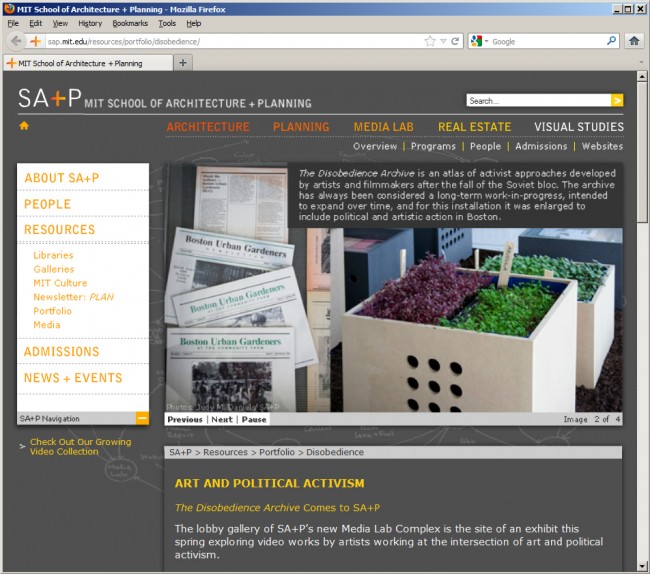Art and Political Activism
The Disobedience Archive Comes to SA+P
Posted March 2012
http://sap.mit.edu/resources/portfolio/disobedience
The lobby gallery of SA+P’s new Media Lab Complex is the site of an exhibit this spring exploring video works by artists working at the intersection of art and political activism.
Founded in 2005, and since exhibited around the world, The Disobedience Archive is an atlas of activist approaches developed by artists and filmmakers after the fall of the Soviet bloc that are currently proliferating on a global scale. Using ‘tactical media’ such as low-cost video and free web access, the DIY techniques offer unprecedented access to those who feel they’ve been damaged by mainstream culture.
The core of the collection focuses on social struggles in Italy, Germany, Argentina, Israel and Palestine, post-9/11 America and other insurrections around the world. But the archive has always been considered a long-term work-in-progress, intended to expand over time, and for this installation it was enlarged to include political and artistic action in Boston.
Originally scheduled through February, then extended through April 15, the installation was curated by SA+P’s Gediminas Urbonas, and his partner Nomeda Urbonas, working with critic and curator Marco Scotini, director of the Visual Arts Department at Nuova Accademia de Belle Arti Milano and curator of Milan’s Gianni Colombo Archive.
It was developed in tandem with last fall’s lecture series in the Art, Culture and Technology Program – Zones of Emergency: Artistic Interventions – directed by Ute Meta Bauer, then director of the ACT program. That series investigated creative responses to conflict and crisis to explore how artistic interventions can disrupt, subvert or transform existing conditions in critical ways.
The exhibit was produced in collaboration with students from two ACT seminars – both taught by Urbonas – that offered students occasion to research, debate and create artworks that examine the notion of disobedience as it relates to history and politics in the Boston area. Student works included:
Tables Talk, an installation by Hailong Wu exploring the student protests at Harvard in 1969. During the strike, the first thing students did was to pile up the tables in classrooms, to re-arrange the space as a way of deconstructing the power structure. Tables Talk freezes such a moment and reconstructs it with different material, different geometry and different functions, turning the tables into stairs, mirrors and sound generators that offer people the chance to revisit a multi-layered sensation of disobedience as it took place in Harvard 1969.
Consent, a multi-channel video work by Alex Auriema comprising video coverage taken by police of the public in protest. Since the US Court of Appeals ruled that citizens have a right to videotape police in action, police have become increasingly wary of making arrests for ‘unlawful’ recording of their actions and have even become creative with their own video recording, stepping up their own right to record the actions of protesters. An open lawsuit in collaboration with the Boston ACLU is seeking to retrieve the footage that the Boston Police Department has captured since the start of Occupy Boston.
Sleeping with Stallman, an installation by Giacomo Castagnola, began as an investigation into the use of dwelling as a protest tactic, such as Occupy Boston’s use of sleeping in public space to disrupt the existing system. The notion of ‘sleeping in public’ as a form of social critique led him to knowledge of Richard Stallman, who lived and slept in his office at MIT in the 1990s as an act of civic disobedience.
Consisting of a soft platform that hosts three sound compilations and three reading sections, Sleeping with Stallman is a ‘hack’ into the exhibition space that references sleeping as a form of political resistance.
microBUG, an installation by Joan Chen, was inspired while researching histories of urban gardening in Boston. Chen studied the Southwest Corridor Park, an area that was cleared for a proposed interstate during the country’s peak of highway projects only to be terminated in 1969 due to extensive community protests. The need to heal the urban scar left by mass demolition was met by building a public green space featuring community gardens to stitch the neighborhoods back together in a form that combines food production, neighborhood renewal and ongoing discussion of urban agriculture.
For this exhibit, the MIT Museum also loaned digital scans of original protest posters from their general collection, documenting actions at MIT during the Vietnam Era. And iHuman, a collaborative project by Caleb Benjamin Harper, Ali Khalid Qureshi and Summer Stephanie Sutton, provided visitors with an avatar that could move around the environment, allowing the controller to experience the physical space in a manner both anonymous and remote.
The Disobedience Archive was produced at MIT with help from SA+P’s Office of the Dean, Julian Bonder, Paul Summit, Mel King and Juliet Stone. It was funded by the Grants Program of the Council for the Arts at MIT and a Director’s Grant from the Council for the Arts at MIT.
For more information visit disobedience.mit.edu. Read more in Domus (in Italian)
PLAN 81
Posted March 2012
